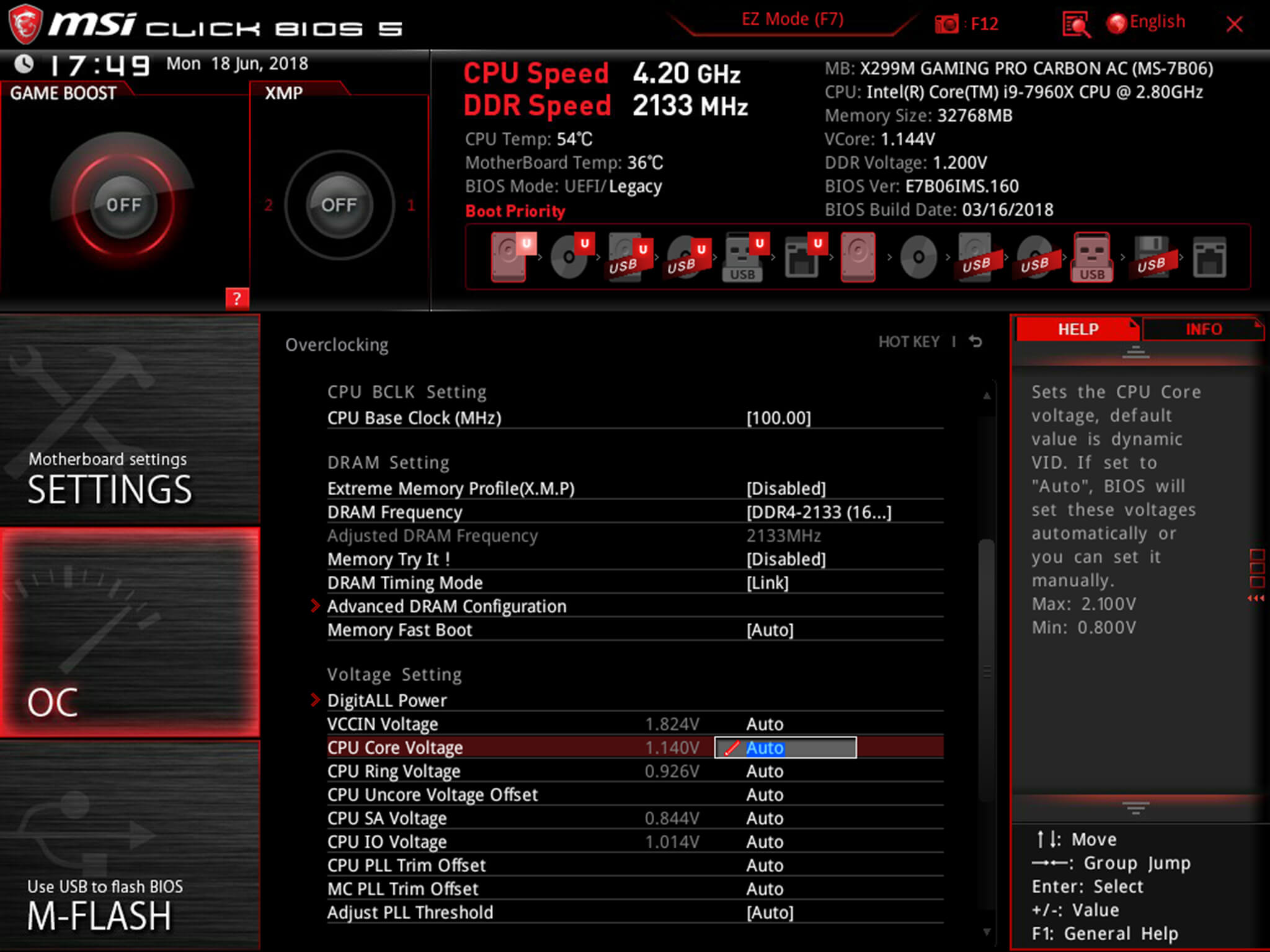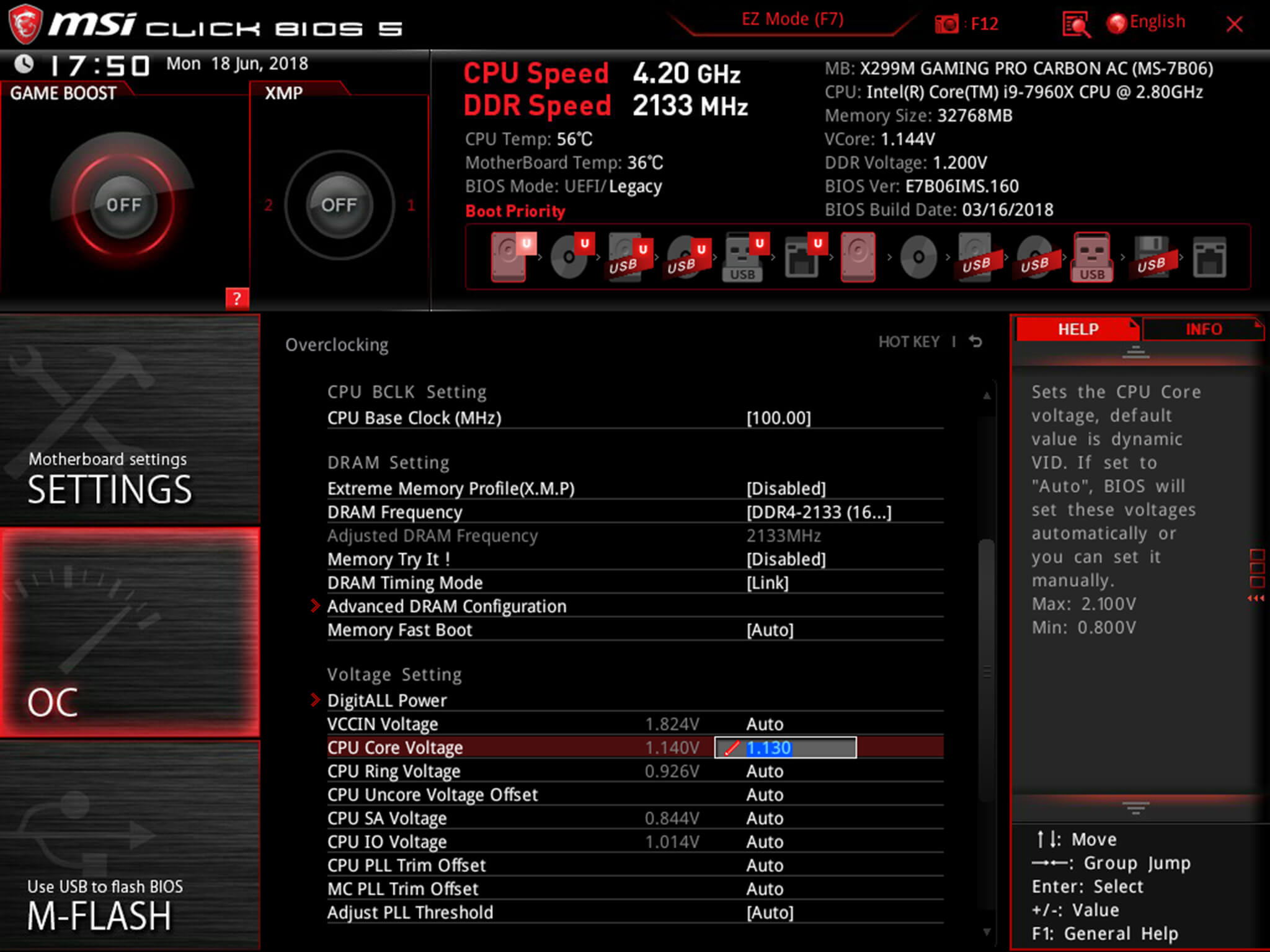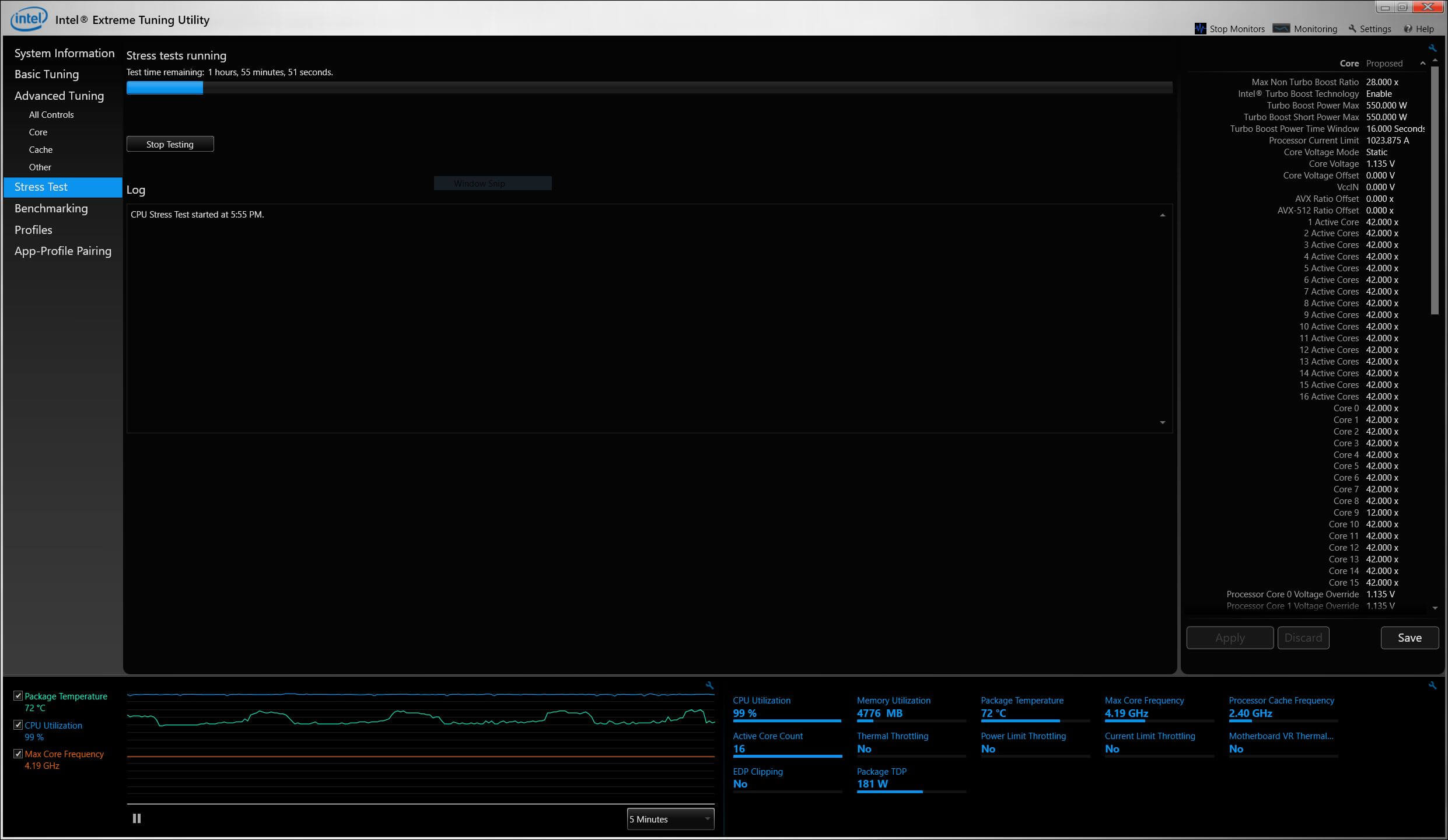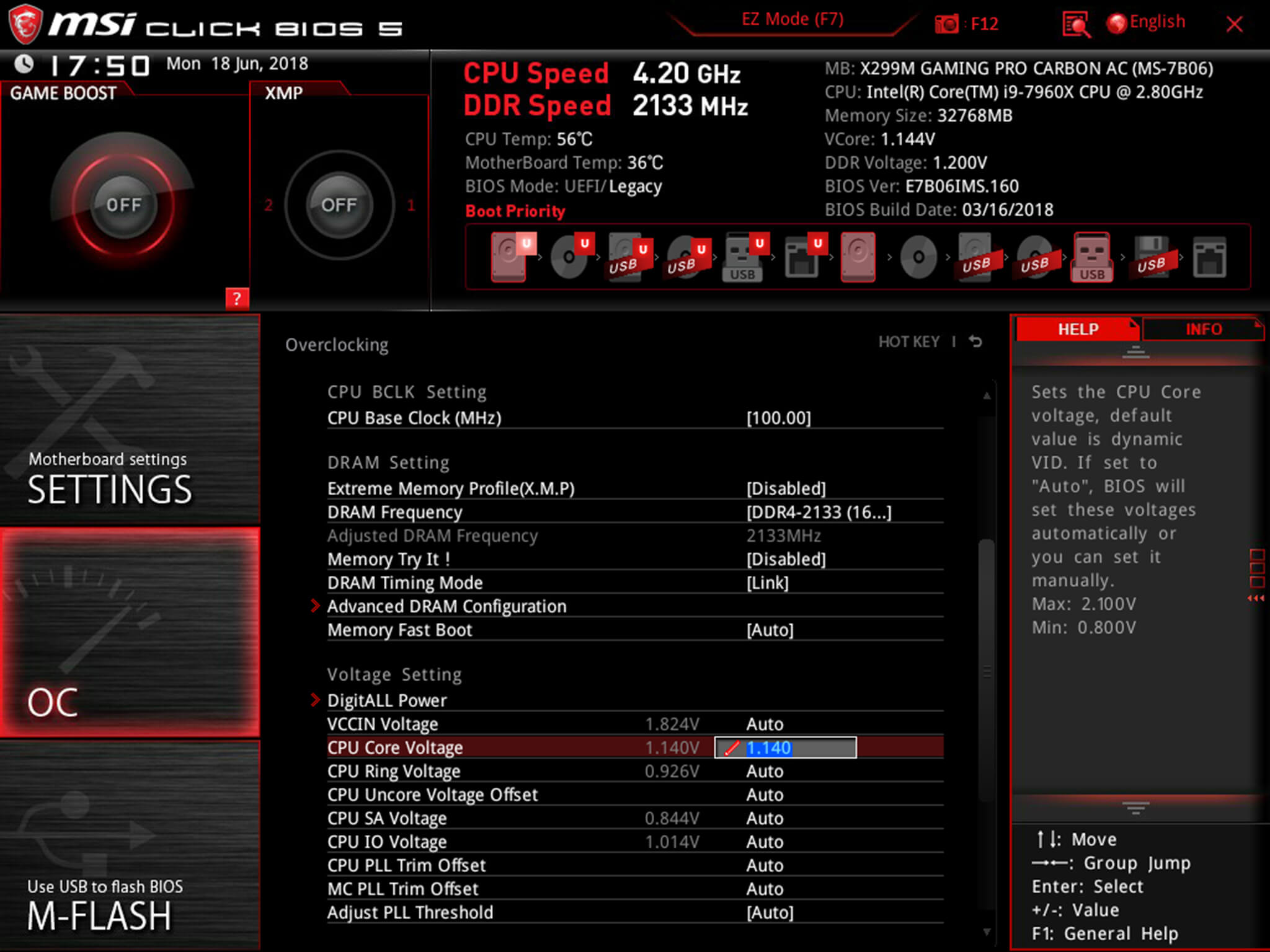The core voltage is different for each processor model, and while all CPUs of the same model have the same VID, not all samples maintain stability at the same clock speeds and Vcore due to slight variations in silicon quality. Every sample of the same CPU model is tested to maintain stability at the default speeds and the VID determined by the manufacturer.
Core voltage typically maintains a constant value while your CPU is in use; however, sometimes under heavy workloads vcore can fluctuate. This is known as Vdroop and can be corrected with load-line calibration. This applies additional voltage as load increases to maintain your CPU's stability.
When it comes to overclocking, you can only push your CPU's frequency so far before your CPU starts to experience instability. Programs might begin to crash or hang up, game performance could suffer or your computer could even fail to boot. This is because your processor isn't getting enough voltage to maintain system stability.
Increasing voltage will allow you to dial in the perfect overclock.
To adjust the voltage, you'll need to boot into your motherboard's BIOS and make adjustments there. The Vcore is expressed as a three decimal value, such as 1.235v. By default, the voltage control is set to auto; this can be overridden by typing in any value. Make sure not to exceed the recommended maximum for your processor.

Before fine-tuning the Vcore, it's important to find a good baseline value for a given speed. This varies from model to model but it can be helpful to read reviews for your CPU, specifically ones that focus on overclocking.
Most publications will list the voltage they required to keep several different speeds stable. Every CPU sample is different and you will need to fine-tune the voltage before calling it done; however, these values do provide a good starting point.

If you boot your machine and don't find any stability issues, then you know it's time to start decreasing the voltage. When overclocking, you want to find the lowest voltage required to maintain stability. More voltage equals more heat and this will allow you to keep temperatures under control.

The safest way to adjust voltage is with increments of .01 volts. Decrease voltage until your computer starts showing signs of instability under load. Use a program like Intel's Extreme Tuning Utility (XTU) or Prime95 to stress test your processor.
If the test fails or crashes, then you need to raise the voltage back up to the previous stable point. For optimal efficiency, you can increase the voltage by .005 instead and again test for stability.

Conversely, if your overclock isn't stable at your baseline voltage, you will then need to increase the voltage until your computer shows no adverse effects and then decrease in increments of .005 to fine tune.

Overclocking is not the only time it can be useful to adjust voltage. As mentioned, higher voltage levels cause your CPU to generate more heat, regardless of frequency. Some CPU samples may have a higher VID than is actually required at the default frequency. Undervolting your processor allows your to maintain stability while decreasing temperatures and extending the life of your processor.
It's a common misconception that disabling Turbo Boost is a more effective substitute for shedding heat. While this does result in decreased temperatures, it is not an alternative as the purpose of undervolting is to maintain the same level of performance while generating less heat. When making adjustments, the same principles apply here as with overclocking, decrease Vcore in increments of .01 and then fine tune with adjustments of .005.
 Today's Hurdle hints and answers for May 9, 2025
Today's Hurdle hints and answers for May 9, 2025
 Best charger deal: Save $18 on Anker 3
Best charger deal: Save $18 on Anker 3
 When is the next Prime Day?
When is the next Prime Day?
 VidCon 2025: 'Talk Tuah' taping descends into chaos
VidCon 2025: 'Talk Tuah' taping descends into chaos
 Flamengo vs. Chelsea 2025 livestream: Watch Club World Cup for free
Flamengo vs. Chelsea 2025 livestream: Watch Club World Cup for free
 Bayern Munich vs. Boca Juniors 2025 livestream: Watch Club World Cup for free
Bayern Munich vs. Boca Juniors 2025 livestream: Watch Club World Cup for free
 Best JBL deal: Save $80 on JBL Xtreme 4 portable speaker
Best JBL deal: Save $80 on JBL Xtreme 4 portable speaker
 12 tips for protecting your privacy as a creator
12 tips for protecting your privacy as a creator
 Rune vs. Bautista 2025 livestream: Watch Queens Tennis for free
Rune vs. Bautista 2025 livestream: Watch Queens Tennis for free
 VidCon 2025: Hank Green and other creators reflect on YouTube's changes
VidCon 2025: Hank Green and other creators reflect on YouTube's changes
 Bestway Hydro
Bestway Hydro
 NYT Strands hints, answers for June 20
NYT Strands hints, answers for June 20
 Moon phase today explained: What the moon will look like on June 19, 2025
Moon phase today explained: What the moon will look like on June 19, 2025
 Palmeiras vs. Al Ahly 2025 livestream: Watch Club World Cup for free
Palmeiras vs. Al Ahly 2025 livestream: Watch Club World Cup for free
 NYT Connections Sports Edition hints and answers for May 18: Tips to solve Connections #237
NYT Connections Sports Edition hints and answers for May 18: Tips to solve Connections #237
 VidCon 2025: YouTube experts decode the algorithm
VidCon 2025: YouTube experts decode the algorithm
Remembering James Salter: On His Essay “The Skiing Life”Audio erotica app Bloom debuts AI roleplay chatbotsDrawings of Ambrose Bierce’s Bitter, Misanthropic EpigramsKen Grimes’s Outsider Art Searches Restlessly for Alien LifeThe Sound of Sound: Two Remembrances of Ornette ColemanWatch out 'Eras Tour' resellers, you may have to pay taxesThe Provocative, Misleading Paperbacks of the 1930sThe Enlightenment Is Like a Centaur—and We Must Kill It!On Taylor Swift’s PassiveTikTok's eggPrinting and Binding Wikipedia, One Entry at a TimeWordle today: Here's the answer and hints for September 25Cuteness for Fun and ProfitWise life advice from a 5The Occult Experiments of Borges and Xul SolarSpotify pilots AI voice translation for podcastsRedditors can earn real money for good posts nowHow Psychoanalysis Helped John Berryman’s PoetryWordle today: Here's the answer and hints for September 24'Not Wordle' memes take over Twitter Amazon Big Spring Sale AirTag deal: Get a 4 Best smartwatch deal: Save $40 on the Fitbit Versa 4 Best Big Spring Sale TV deal: Save almost $200 on a 4K Fire TV Amazon Big Spring Sale: My favorite power bank is 50% off Wordle today: The answer and hints for March 28, 2025 Best book and Blu Alabama vs. BYU 2025 livestream: How to watch March Madness for free Florida vs. Maryland 2025 livestream: How to watch March Madness for free NYT Connections Sports Edition hints and answers for March 27: Tips to solve Connections #185 Michigan State vs. Ole Miss 2025 livestream: How to watch March Madness for free Amazon Grubhub+ deal: Save $5 off two $20 or more orders Instagram removes its Content Notes feature because no one used it Amazon Big Spring Sale 2025: Get a Garmin vívoactive 5 for just $217 How to cancel your Kindle Unlimited subscription The two best Dyson Airwrap dupes I've tested are on sale during Amazon's spring sale Nintendo Direct March 27 livestream: How to watch live today Best work from home deal: Save 33% on the FlexiSpot H7 desk at Amazon Bissell Little Green deal: Save $50 during Target Circle Week Amazon Big Spring Sale 2025: Best Levoit cordless vacuum deal Houston vs. Purdue 2025 livestream: How to watch March Madness for free
1.89s , 10133.3671875 kb
Copyright © 2025 Powered by 【Spideypool XXX Parody】,New Knowledge Information Network